Before the bungalows arrived the chemical works, cholera hospital, coastguard station, and a few boat and fishermen’s huts were about the only buildings on the beach. The location of the earliest bungalows can be seen on the 1898 Ordnance Survey map. Matching this to the 1930’s Bungalow Town map and lists shows that these first bungalows were named, from west to east, Kittiwake, Arcadia, Struan Lee, Rhodesia, Lazyland, Sea View, Sea Spray, Coronation, Shoreham Dene, Waterville and Canaan (the empty rectangles were plots for later bungalow to be built on them but some don’t seem to have materialised.

Photographs and postcards of these first bungalows in their early years are scarce but there are a few.
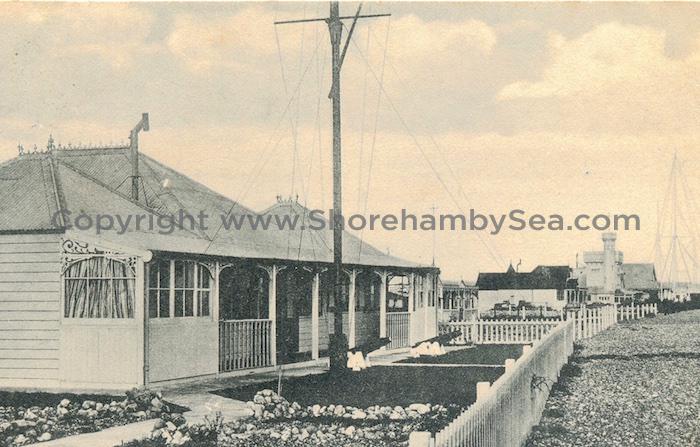
The most westerly of these bungalows named Kittiwake was sited on the beach just below the eastern tip of Widewater. It only survived until 1911 when it burned down and was rebuilt. Beyond it in the distance is the dark roof of Straun Lee and the castle-like Rhodesia.
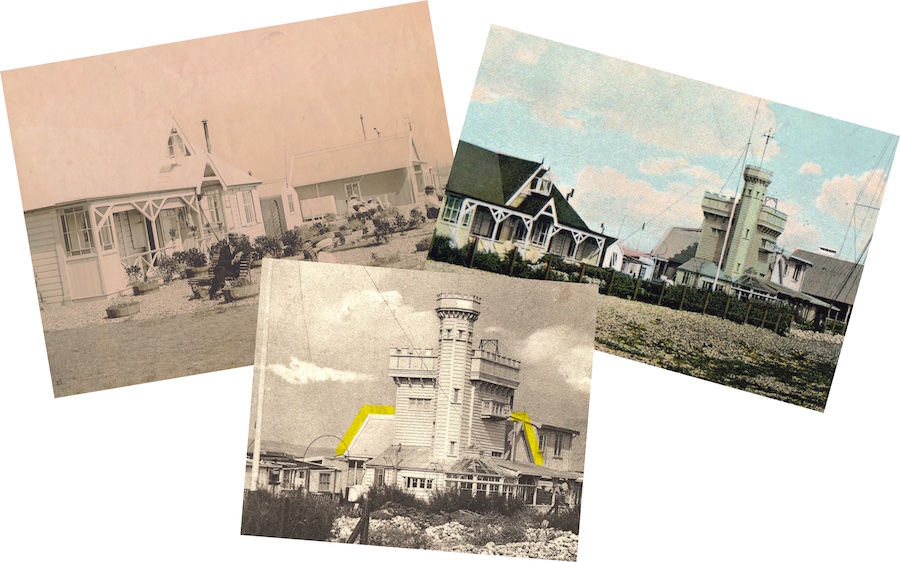
The next photo takes us a little further eastwards. It is an older image than the previous photo, somewhat over exposed, shows Struan Lee in its earlier, smaller form and beyond it the plain bungalow that preceded the Rhodesia rebuilding. The later photo alongside it is from a hand coloured postcard showing Struan Lee with a taller roof and extension of the decorative porch supports to the right hand side. Behind stands the impressive Rhodesia but only a few years later it became yet another Bungalow Town building to be destroyed by fire. The lower photo shows how the original bungalow was incorporated into the new building.
Famous music hall artists and other entertainers provided the most influence in popularising the attractions of life in Bungalow Town but 1930’s local historian Arthur Wilde reckoned Shoreham’s oyster merchant and fisherman Sam Maple was the true pioneer.
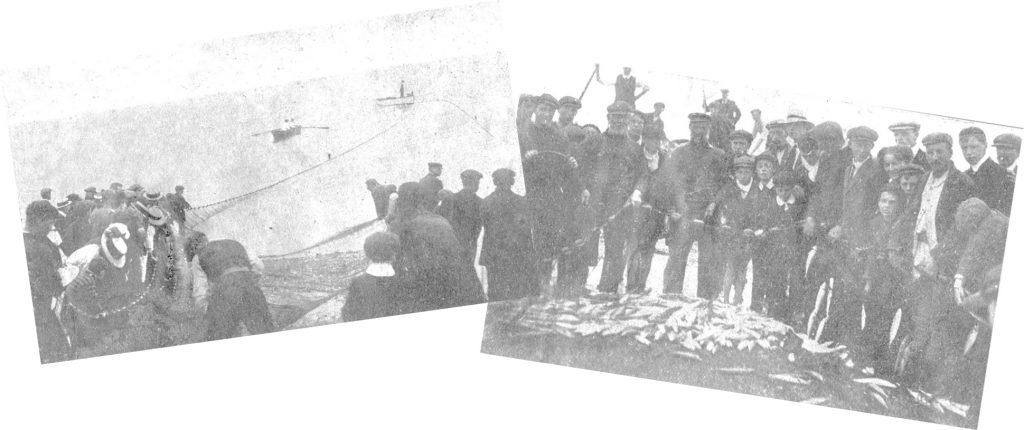
Each fishing family had their own stretches of beach where they kept their boats and fished from. Wilde tells us that in 1879 Sam had a railway carriage towed over the river and sited on the Beach for use as storage for his fishing equipment but also as a bathing hut. This carriage was later included as part of the bungalow Sea View that we know, from old directories and maps of named bungalows was located on the beach at the spot just below where the Church of the Good Shepherd was subsequently built.
Sea View was later split into two properties. The western half of which was built up to two storeys retaining the same name and the eastern, single storey half renamed Beach Court.
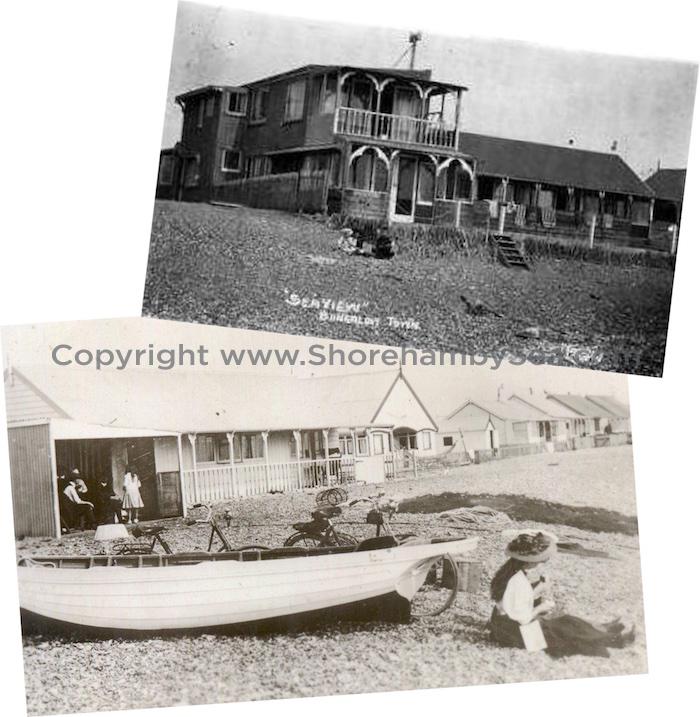
Amongst photographs recently found in part of the collections of the late Shoreham historian, Michael Norman, is one noted by him on the reverse ‘First bungalow on Shoreham beach c.1890.’ This shows a Victorian railway carriage on a shingle beach with the sea behind. A good quality hipped roof has been added with a small decorative dormer and gable ends. The photo provides no other clues as to the location – could this have been Sam Maple’s carriage? It is perhaps difficult to imagine it was and in any case its appearance as shown here didn’t last very long before it was completely covered by the enlargement work that was to eventually evolve into the two, semi-detached properties.
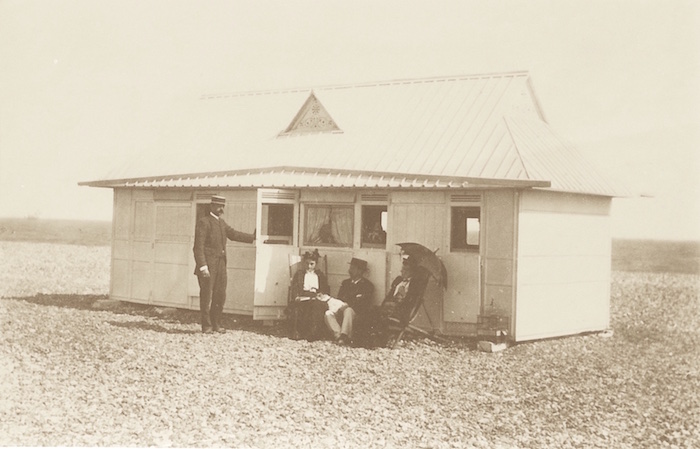
Michael Norman was known to be a stickler for historical accuracy so it is most unlikely he would have made the notation on the photo’s reverse without good reason. However, there are no other records in this part of the collection to confirm that. The original collection was considerable, a priceless record of Shoreham’s past but was broken up and sold off after his death. Perhaps the answer still lies somewhere amongst the other surviving parts of the collection?
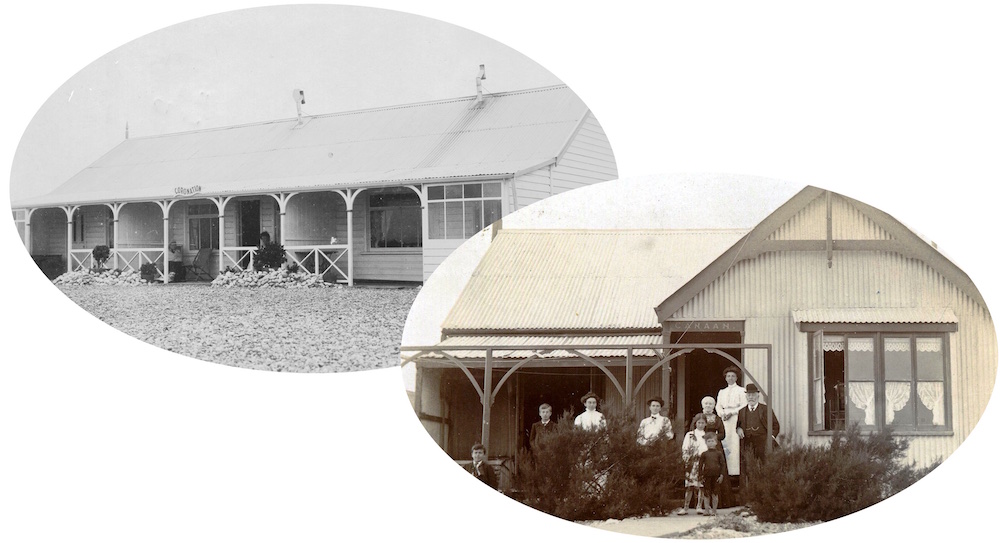

It shows two railway carriages and a simple bungalow that at first sight looks to have been randomly photographed. Its title reads ‘Some of the First Bungalows on Shoreham Beach’ but with no indication of the date, which bungalow it is and the actual location.
There is more than one claim as to the first bungalow to be built both with and without railway carriages and another was held to be Sea Spray built from a railway carriage in 1893 by John Steddiford. His brother in law Thomas Lee actually lived in it and in doing so was thought to be the first resident of Bungalow Town. Steddiford then went on to build more including the neighbouring Coronation then Waterville amongst others. (Worthing Herald article 1st September 1934) The inclusion of a carriage does not seem evident from the photo’s external view although there were many railway carriage bungalows where the integral carriages were hidden.
What does the photo tell us?
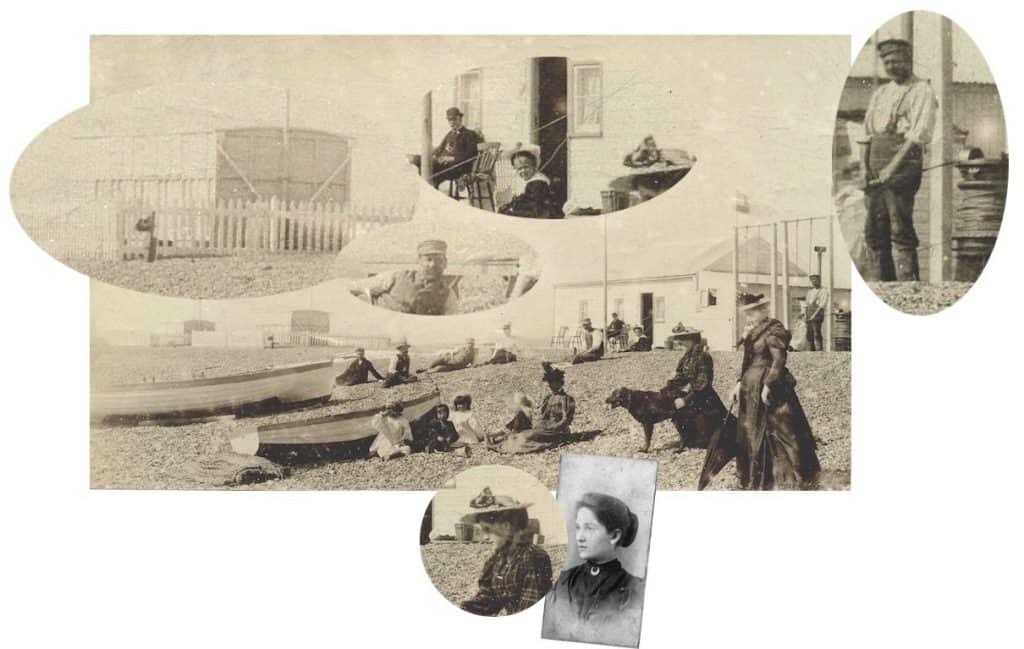
The railway carriages are still clad in their wooden panels over the doors and windows for protection during transit and the picket fences look new.
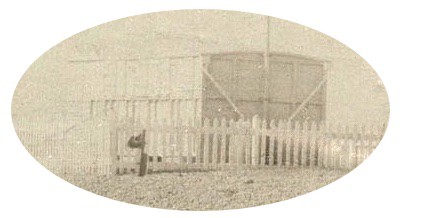
There appears to be decking or a foundation for a forthcoming new building or extension mounted on timbers where the shingle drops away next to the bungalow.

Bill Winton often included members of his family and friends in his photos and this is no exception. At first sight the impression may be of a spur of the moment photo but on further consideration the characters look to be arranged, carefully positioned and most everybody is looking at the camera. There are eighteen individuals in the group but the rest of the beach is deserted instead of being spread out as would normally be expected.
The girl with the dog bears a very striking resemblance to other photos of a young Mary Hedgecock, Bill Winton’s fiancee (they married in 1901). This is reinforced by the dog which was a family pet that can also be seen in other photos in the family album – another suggestion of scene ‘arranging.’
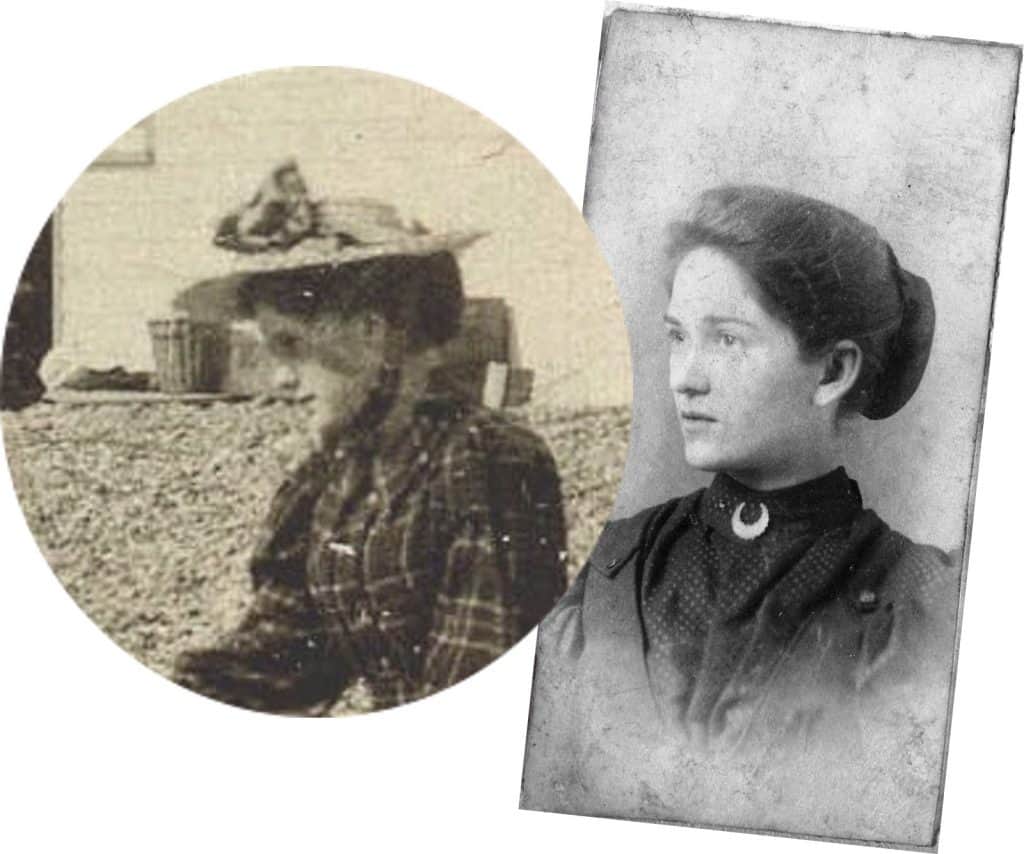
The elderly lady with the umbrella wears a dress that dates from a decade or so earlier from the rest of the group and tends to provide a misleading impression of the date of the photo. There are many beach crowd photos from the same period but few if any appear to include the older generations who would have found it difficult walking over sloping shingle. Again, a relative or acquaintance perhaps.
The Wintons were well known amongst the fishing community often taking photos of them and this photo looks to have involved them too. At least three men wear fishermen’s Breton style caps, fishing boats lie nearby and at the right of the photo a fisherman holds the rope or wire cable from a capstan as if in readiness to haul up a boat – another posed aspect?
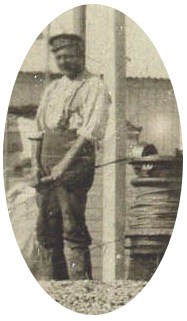
The 1912 Ordnance Survey map shows two capstans, one between Shingle Lodge and Sea Spray bungalows and the other between Etheldene and Shoreham Dene. Photos of before and after that period confirm these locations but also that the capstans were sometimes marginally resited yet still remaining in those same general areas.
Some of the fishing families, including the Maples who the Wintons knew well and intermarried with, were also involved in building and repairing bungalows. Here at one of their locations by the capstan they look to have seen an opportunity for making a few extra pennies by erecting swings. They also made and rented out beach huts for changing in and photos over the years show these huts consistently in the same area as the swings. The interesting point here though is that close inspection show cords still attached to the top of the swings. These don’t seem substantial enough to alone take the weight of swings in motion (subsequent photos show that angled supporting struts were added later) and are more likely to have been the cords recently used to hold the posts in position whilst erecting them.
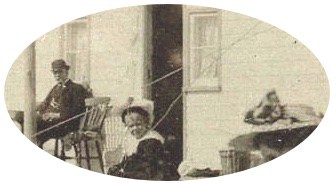
The group of children in the centre foreground were originally thought to include Bill Winton’s own offspring. However, they look to be between two and three years of age that from their years of birth would put this photo at about 1906 but a 1901 postcard (below) shows the newly erected swings in the main photo to be in situ before their children were born.
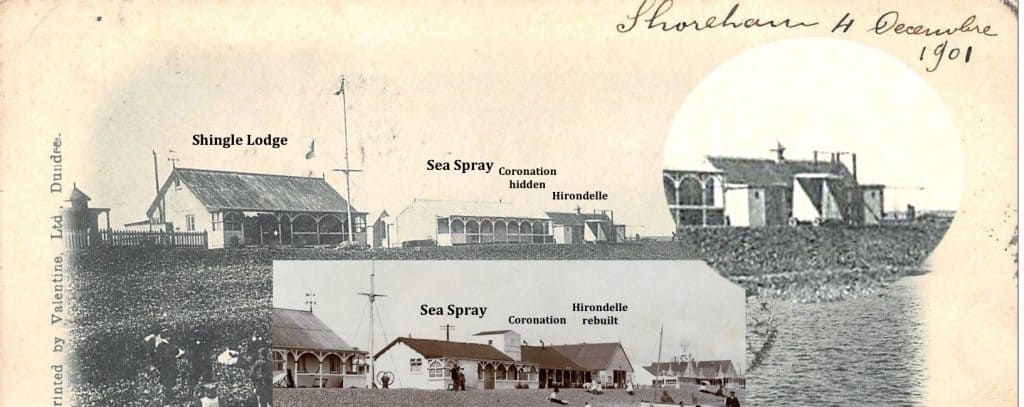
There is only one location where swings are to be seen in Bungalow Town photos and that is outside Hirondelle bungalow – this one (top) is from a postcard that was posted in 1901 when the bungalow still sported its roof cupola. Looking at the enlarged circular inset he tops of the swings can be seen and an angled supporting strut looks to have been added. To the right of them a low shape can be made out at the spot where the capstan is. The second, later photo shows Sea Spray’s added roof gable extension and Coronation visible between it and the rebuilt Hirondelle

The Hirondelle and Coronation bungalows would be out of shot to the right of Bill Winton’s photo if they had been built by then. Could the simple looking bungalow be the neighbouring Sea Spray before it was extended and a porch added? Apart from the length the proportions of the building, height, gable end etc., look very similar.
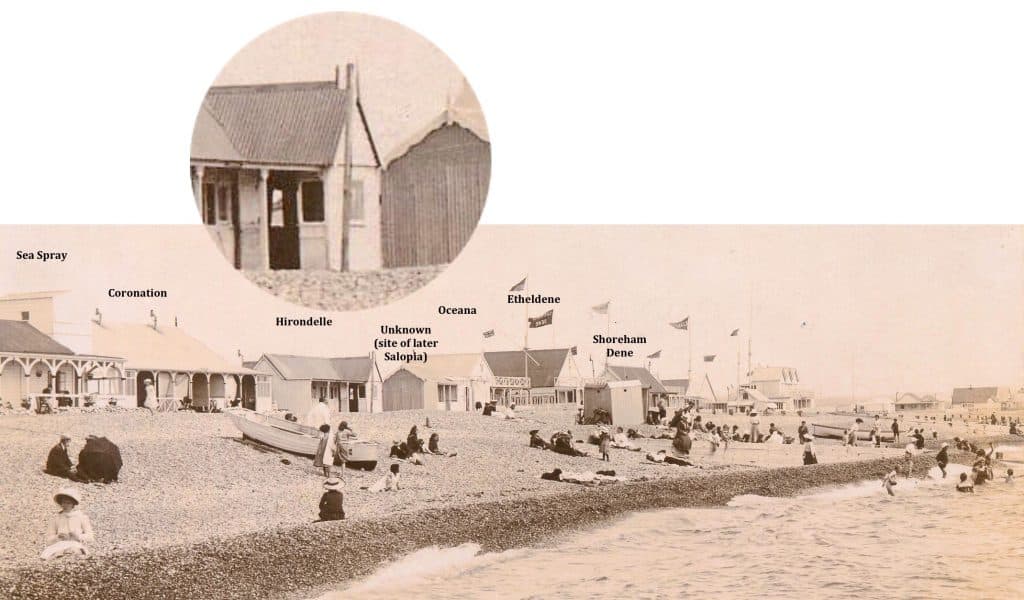
An even later photo of the area now fully developed shows the bungalows including Hirondelle prior to 1917 before it was also rebuilt. Although the swings are gone the enlarged inset reveals one of the posts is still there!
Nothing conclusive but enough clues perhaps to suggest the date of Bill Winton’s photo as being the mid 1890’s, a beach location a hundred yards or so east of where the church was later to be built and the earliest known photo of Sea Spray, Bungalow Town’s first residential bungalow …………..could that be Tom Lee in bowler hat sitting next to the doorway?

Roger Bateman
Shoreham September 2017 – updated April 2021
One final aside concerns the Maple family who were to be further involved in Bungalow Town’s history when Sam Maple’s son, Arthur, became romantically involved with near neighbour Agnes Rhodes, a widow who owned and lived at ‘Rhodesia’ – their story and that of the impressive castle-like ‘bungalow’ is covered in the separate article Rhodesia – a special ‘bungalow’ http://www.shorehambysea.com/rhodesia-special-bungalow/ Arthur was later to become the Superintendant of Works for the Shoreham Sea Defence Commisioners.
Sources:
1917 Bungalow Town property map and listings – see http://www.shorehambysea.com/bungalow-town-property-map-index/
1935 Bungalow Town property map and listings – see http://www.shorehambysea.com/bungalow-town-property-map-1935/
1938/9 Town Guide
Winton Family Album
ShorehambySea.com photo collections
Sussex Archaeological Society Marlipins Collection
Rhodesia – a ‘special’ bungalow – Roger Bateman – see http://www.shorehambysea.com/rhodesia-special-bungalow/


can you help please.
I am trying to find the date of death of Arthur
Wilde, newspaper writer and historian. He and wife Gladys spent some years of WW II in Moretonhampstead Devon where she died in 1945. he returned to Sussex to write for the Sussex Daily News.
He seemed to have lived at Crowborough.
Can you help with his date of death?
I’m afraid we don’t have any record of Arthur Wilde’s passing Colin and I’m sure you would already have tried the Free BMD website. If you’ve not already seen it we do have a little on him in the Winton Collection item references W12el and W12em.